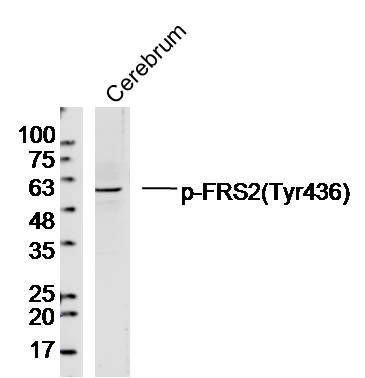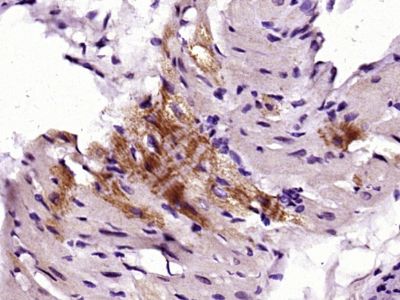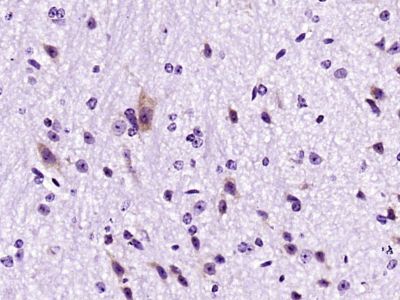Adapter protein that links FGR and NGF receptors to downstream signaling pathways. Involved in the activation of MAP kinases. Modulates signaling via SHC1 by competing for a common binding site on NTRK1.
Tissue specificity:Highly expressed in heart, brain, spleen, lung, liver, skeletal muscle, kidney and testis.
Function:
Adapter protein that links activated FGR and NGF receptors to downstream signaling pathways. Plays an important role in the activation of MAP kinases and in the phosphorylation of PIK3R1, the regulatory subunit of phosphatidylinositol 3-kinase, in response to ligand-mediated activation of FGFR1. Modulates signaling via SHC1 by competing for a common binding site on NTRK1.
Subunit:
Part of a complex containing FRS2, GRB2, GAB1, PIK3R1 and SOS1. Part of a complex containing GRB2 and CBL. Identified in a complex containing FGFR4, NCAM1, CDH2, PLCG1, FRS2, SRC, SHC1, GAP43 and CTTN. Binds RET (By similarity). Binds ALK, FGFR1, CKS2, MAPK1/ERK2, MAPK3/ERK1 and SRC. The tyrosine-phosphorylated protein binds the SH2 domains of GRB2 and PTPN11. Interacts with NTRK1, NTRK2 and NTRK3 (phosphorylated upon ligand-binding).
Subcellular Location:
Endomembrane system. Note=Cytoplasmic, membrane-bound.
Tissue Specificity:
Highly expressed in heart, brain, spleen, lung, liver, skeletal muscle, kidney and testis.
Post-translational modifications:
Phosphorylated by ULK2 in vitro (By similarity). Phosphorylated on tyrosine residues upon stimulation by NGF or FGF2. Phosphorylated on tyrosine residues by activated ALK and FGFR1. Phosphorylated on tyrosine residues upon activation of FGFR2 and FGFR3. Phosphorylated on threonine residues by MAP kinases; this inhibits tyrosine phosphorylation, and thereby down-regulates FRS2-mediated activation of MAP kinases.
Ubiquitinated when tyrosine phosphorylated and in a complex with GRB2. The unphosphorylated form is not subject to ubiquitination (By similarity).
Similarity:
Contains 1 IRS-type PTB domain.
SWISS:
Q8WU20
Gene ID:
10818
Database links:
Entrez Gene: 10818 Human
Entrez Gene: 327826 Mouse
Entrez Gene: 314850 Rat
Omim: 607743 Human
SwissProt: Q8WU20 Human
SwissProt: Q8C36 Mouse
Unigene: 593446 Human
Unigene: 135965 Mouse
Unigene: 22182 Rat
| Picture |
Sample: Cerebrum (Mouse) Lysate at 40 ug
Primary: Anti-p-FRS2(Tyr436) (SL7902R) at 1/300 dilution
Secondary: IRDye800CW Goat Anti-Rabbit IgG at 1/20000 dilution
Predicted band size: 57 kD
Observed band size: 57 kD
Paraformaldehyde-fixed, paraffin embedded (Rat heart); Antigen retrieval by boiling in sodium citrate buffer (pH6.0) for 15min; Block endogenous peroxidase by 3% hydrogen peroxide for 20 minutes; Blocking buffer (normal goat serum) at 37°C for 30min; Antibody incubation with (phospho-FRS2(Tyr436)) Polyclonal Antibody, Unconjugated (SL7902R) at 1:400 overnight at 4°C, followed by operating according to SP Kit(Rabbit) (sp-0023) instructionsand DAB staining.
Paraformaldehyde-fixed, paraffin embedded (Rat brain); Antigen retrieval by boiling in sodium citrate buffer (pH6.0) for 15min; Block endogenous peroxidase by 3% hydrogen peroxide for 20 minutes; Blocking buffer (normal goat serum) at 37°C for 30min; Antibody incubation with (phospho-FRS2(Tyr436)) Polyclonal Antibody, Unconjugated (SL7902R) at 1:400 overnight at 4°C, followed by operating according to SP Kit(Rabbit) (sp-0023) instructionsand DAB staining.
|
|
|


